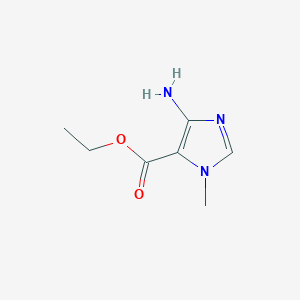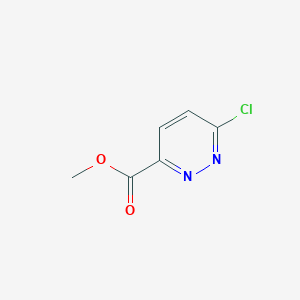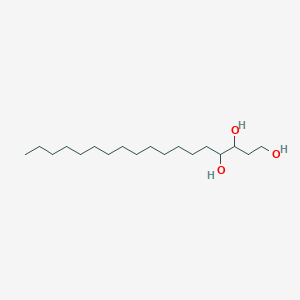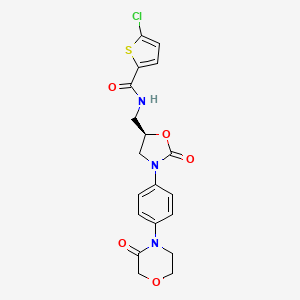
5-R-Rivaroxaban
Overview
Description
5-R-Rivaroxaban is the R-enantiomer of Rivaroxaban . Rivaroxaban is an anticoagulant that presents as a mechanism of action the direct and selective inhibition of activated coagulation factor X (FXa) and has a chiral center in its molecular structure . It is used to treat or prevent blood clots (venous thromboembolism, or VTE) .
Synthesis Analysis
An alternative synthesis method of rivaroxaban has been developed with an overall yield of 24%, and diminished reaction times . An efficient and facile synthetic method to synthesize rivaroxaban (1) in 39% global yield from ®-2-(chloromethyl)oxirane over six steps using a Goldberg coupling reaction as a key step .
Molecular Structure Analysis
Rivaroxaban has a chiral center in its molecular structure, but only the (S)-Rivaroxaban enantiomer presents pharmacological activity . The spatial conformation of a molecule is closely connected to its interaction with the human body .
Chemical Reactions Analysis
Rivaroxaban inhibits endogenous FXa more potently in human and rabbit plasma (IC 21 nM) than rat plasma (IC 290 nM). It demonstrates anticoagulant effects in human plasma, doubling prothrombin time (PT) and activates partial thromboplastin time at 0.23 and 0.69 μM, respectively .
Physical and Chemical Properties Analysis
The physical and chemical properties of this compound are as follows: Molecular Formula: C19H18ClN3O5S, Molecular Weight: 435.88 . It is a solid substance with high oral bioavailability (80–100 %) for the 10 mg tablet irrespective of food intake and for the 15 mg and 20 mg tablets when taken with food .
Scientific Research Applications
Enhanced Biopharmaceutical Performance
Rivaroxaban (RXB) demonstrates promising potential in enhancing biopharmaceutical performance. It's an orally active direct inhibitor of the activated serine protease Factor Xa, primarily used in the treatment of venous thromboembolism (VTE). Research has shown that its solubility and permeability can be significantly improved through the preparation of polymeric amorphous solid dispersions (ASDs). Such formulations, particularly with soluplus, lead to a substantial increase in apparent solubility and sustained supersaturation, indicating a promising strategy for optimizing RXB's biopharmaceutical attributes by increasing solubility and circumventing P-gp activity (Metre et al., 2018).
Clinical Pharmacokinetic and Pharmacodynamic Profile
The pharmacokinetic and pharmacodynamic profile of Rivaroxaban is a key area of investigation. It targets free and clot-bound Factor Xa as well as Factor Xa in the prothrombinase complex. The drug is rapidly absorbed, with high oral bioavailability and moderate variability in its pharmacokinetic parameters. Its elimination from plasma occurs with a terminal half-life of 5-9 hours in healthy young subjects and 11-13 hours in elderly subjects. The pharmacokinetic and pharmacodynamic relationship is closely correlated, indicating a significant relationship between plasma concentration and the inhibition of Factor Xa activity (Mueck et al., 2013).
Metabolism and Excretion
Understanding the metabolism and excretion of Rivaroxaban is crucial for its clinical application. Studies have shown that it is rapidly excreted with high recovery rates in rats, dogs, and humans. The major compound in plasma at all time points investigated across these species is unchanged Rivaroxaban. The primary metabolic pathways include oxidative degradation of the morpholinone moiety and hydrolysis of central amide bonds. In humans, about 66% of the dose is excreted renally, and 28% in the feces, highlighting the drug's metabolic pathways and excretion profiles (Weinz et al., 2009).
Rivaroxaban in Thromboembolic Disease Management
Rivaroxaban is widely used for the prevention and treatment of thromboembolic disorders. Its role as a non-vitamin K antagonist oral anticoagulant that acts as a direct factor Xa inhibitor is pivotal in thrombosis management. Research programs continue to explore rivaroxaban’s broader benefits, especially in the context of vascular protection. It's being studied for potential roles in stroke prevention, venous protection, and other thromboembolic conditions, offering a single-drug approach for the treatment of venous thrombosis (Camm, 2018).
Mechanism of Action
Target of Action
5-R-Rivaroxaban, commonly known as Rivaroxaban, is an anticoagulant and the first orally active direct factor Xa inhibitor . Its primary target is Factor Xa, a coagulation factor that plays a central role in the coagulation cascade . Factor Xa is needed to activate prothrombin (factor II) to thrombin (factor IIa) .
Mode of Action
Rivaroxaban competitively inhibits free and clot-bound factor Xa . By blocking the activity of Factor Xa, Rivaroxaban prevents thrombin generation, thereby exerting its anticoagulant effect . This inhibition of Factor Xa activity by Rivaroxaban is closely correlated with its plasma concentration .
Biochemical Pathways
Rivaroxaban affects the coagulation pathway by inhibiting Factor Xa. Factor Xa occupies a central position in the coagulation cascade, being activated by both the intrinsic and extrinsic coagulation pathways . By inhibiting Factor Xa, Rivaroxaban effectively blocks the conversion of prothrombin (Factor II) to thrombin (Factor IIa), thus preventing the formation of fibrin clots .
Pharmacokinetics
Rivaroxaban exhibits predictable pharmacokinetics. It is absorbed rapidly, with maximum plasma concentrations being reached 2–4 hours after tablet intake . The oral bioavailability of Rivaroxaban is high (80–100%) for the 10 mg tablet . Elimination of Rivaroxaban from plasma occurs with a terminal half-life of 5–9 hours in healthy young subjects and 11–13 hours in elderly subjects . Rivaroxaban has a dual mode of excretion with the renal route accounting for one-third of the overall elimination of unchanged active drug .
Result of Action
The primary result of Rivaroxaban’s action is anticoagulation, which is achieved by inhibiting Factor Xa and thus preventing thrombin generation . This leads to a reduction in the formation of fibrin clots, thereby preventing thromboembolic events .
Action Environment
Environmental factors such as diet and concomitant medications can influence the action of Rivaroxaban. Furthermore, the pharmacokinetics of Rivaroxaban is consistent across a broad range of different patient populations studied , suggesting that individual patient characteristics may also influence its action.
Safety and Hazards
Rivaroxaban can cause you to bleed more easily. Call your doctor at once if you have signs of bleeding such as: bruising or bleeding that will not stop (nosebleeds, bleeding gums, heavy menstrual bleeding); pain, swelling, new drainage, or excessive bleeding from a wound . Avoid breathing mist, gas or vapours. Avoid contacting with skin and eye. Use personal protective equipment. Wear chemical impermeable gloves. Ensure adequate ventilation .
Biochemical Analysis
Biochemical Properties
5-R-Rivaroxaban competitively inhibits free and clot-bound Factor Xa . Factor Xa is a crucial enzyme in the coagulation cascade, responsible for the conversion of prothrombin to thrombin . By inhibiting Factor Xa, this compound disrupts the coagulation cascade, reducing thrombin generation and clot formation .
Cellular Effects
This compound has been reported to cause some side effects at the cellular level. These include bleeding, feeling dizzy or faint, and changes in some blood tests . It’s also been reported to cause tiredness and lack of energy, shortness of breath, noticeable heartbeats (heart palpitations), and paler than usual skin .
Molecular Mechanism
This compound works by blocking the activity of the clotting protein Factor Xa . This inhibition interrupts the intrinsic and extrinsic pathways of the blood coagulation cascade, inhibiting both thrombin formation and the development of thrombi .
Temporal Effects in Laboratory Settings
This compound has a predictable pharmacokinetic and pharmacodynamic profile. It has a rapid onset of action within 2–4 hours and a half-life of 5–9 hours in healthy young subjects and 11–13 hours in elderly subjects .
Dosage Effects in Animal Models
While specific studies on this compound in animal models are limited, one study found that oral administration of rivaroxaban to cats was safe and well tolerated over a range of doses .
Metabolic Pathways
This compound is metabolized via cytochrome P450 (CYP) 3A4 and CYP2J2, as well as by CYP-independent mechanisms . It has a dual mode of elimination; two-thirds of the drug undergoes metabolic degradation in the liver, half of which is excreted via the kidneys and half via the hepatobiliary route .
Transport and Distribution
This compound is partially excreted by the kidneys, accounting for one-third of the overall elimination of unchanged active drug . It is also a substrate of P-glycoprotein, which can affect its distribution within the body .
Properties
IUPAC Name |
5-chloro-N-[[(5R)-2-oxo-3-[4-(3-oxomorpholin-4-yl)phenyl]-1,3-oxazolidin-5-yl]methyl]thiophene-2-carboxamide | |
|---|---|---|
| Source | PubChem | |
| URL | https://pubchem.ncbi.nlm.nih.gov | |
| Description | Data deposited in or computed by PubChem | |
InChI |
InChI=1S/C19H18ClN3O5S/c20-16-6-5-15(29-16)18(25)21-9-14-10-23(19(26)28-14)13-3-1-12(2-4-13)22-7-8-27-11-17(22)24/h1-6,14H,7-11H2,(H,21,25)/t14-/m1/s1 | |
| Source | PubChem | |
| URL | https://pubchem.ncbi.nlm.nih.gov | |
| Description | Data deposited in or computed by PubChem | |
InChI Key |
KGFYHTZWPPHNLQ-CQSZACIVSA-N | |
| Source | PubChem | |
| URL | https://pubchem.ncbi.nlm.nih.gov | |
| Description | Data deposited in or computed by PubChem | |
Canonical SMILES |
C1COCC(=O)N1C2=CC=C(C=C2)N3CC(OC3=O)CNC(=O)C4=CC=C(S4)Cl | |
| Source | PubChem | |
| URL | https://pubchem.ncbi.nlm.nih.gov | |
| Description | Data deposited in or computed by PubChem | |
Isomeric SMILES |
C1COCC(=O)N1C2=CC=C(C=C2)N3C[C@H](OC3=O)CNC(=O)C4=CC=C(S4)Cl | |
| Source | PubChem | |
| URL | https://pubchem.ncbi.nlm.nih.gov | |
| Description | Data deposited in or computed by PubChem | |
Molecular Formula |
C19H18ClN3O5S | |
| Source | PubChem | |
| URL | https://pubchem.ncbi.nlm.nih.gov | |
| Description | Data deposited in or computed by PubChem | |
DSSTOX Substance ID |
DTXSID20468042 | |
| Record name | 5-R-Rivaroxaban | |
| Source | EPA DSSTox | |
| URL | https://comptox.epa.gov/dashboard/DTXSID20468042 | |
| Description | DSSTox provides a high quality public chemistry resource for supporting improved predictive toxicology. | |
Molecular Weight |
435.9 g/mol | |
| Source | PubChem | |
| URL | https://pubchem.ncbi.nlm.nih.gov | |
| Description | Data deposited in or computed by PubChem | |
CAS No. |
865479-71-6 | |
| Record name | Rivaroxaban, (R)- | |
| Source | ChemIDplus | |
| URL | https://pubchem.ncbi.nlm.nih.gov/substance/?source=chemidplus&sourceid=0865479716 | |
| Description | ChemIDplus is a free, web search system that provides access to the structure and nomenclature authority files used for the identification of chemical substances cited in National Library of Medicine (NLM) databases, including the TOXNET system. | |
| Record name | 5-R-Rivaroxaban | |
| Source | EPA DSSTox | |
| URL | https://comptox.epa.gov/dashboard/DTXSID20468042 | |
| Description | DSSTox provides a high quality public chemistry resource for supporting improved predictive toxicology. | |
| Record name | RIVAROXABAN, (R)- | |
| Source | FDA Global Substance Registration System (GSRS) | |
| URL | https://gsrs.ncats.nih.gov/ginas/app/beta/substances/RJP4GEG36M | |
| Description | The FDA Global Substance Registration System (GSRS) enables the efficient and accurate exchange of information on what substances are in regulated products. Instead of relying on names, which vary across regulatory domains, countries, and regions, the GSRS knowledge base makes it possible for substances to be defined by standardized, scientific descriptions. | |
| Explanation | Unless otherwise noted, the contents of the FDA website (www.fda.gov), both text and graphics, are not copyrighted. They are in the public domain and may be republished, reprinted and otherwise used freely by anyone without the need to obtain permission from FDA. Credit to the U.S. Food and Drug Administration as the source is appreciated but not required. | |
Synthesis routes and methods
Procedure details





Retrosynthesis Analysis
AI-Powered Synthesis Planning: Our tool employs the Template_relevance Pistachio, Template_relevance Bkms_metabolic, Template_relevance Pistachio_ringbreaker, Template_relevance Reaxys, Template_relevance Reaxys_biocatalysis model, leveraging a vast database of chemical reactions to predict feasible synthetic routes.
One-Step Synthesis Focus: Specifically designed for one-step synthesis, it provides concise and direct routes for your target compounds, streamlining the synthesis process.
Accurate Predictions: Utilizing the extensive PISTACHIO, BKMS_METABOLIC, PISTACHIO_RINGBREAKER, REAXYS, REAXYS_BIOCATALYSIS database, our tool offers high-accuracy predictions, reflecting the latest in chemical research and data.
Strategy Settings
| Precursor scoring | Relevance Heuristic |
|---|---|
| Min. plausibility | 0.01 |
| Model | Template_relevance |
| Template Set | Pistachio/Bkms_metabolic/Pistachio_ringbreaker/Reaxys/Reaxys_biocatalysis |
| Top-N result to add to graph | 6 |
Feasible Synthetic Routes
Disclaimer and Information on In-Vitro Research Products
Please be aware that all articles and product information presented on BenchChem are intended solely for informational purposes. The products available for purchase on BenchChem are specifically designed for in-vitro studies, which are conducted outside of living organisms. In-vitro studies, derived from the Latin term "in glass," involve experiments performed in controlled laboratory settings using cells or tissues. It is important to note that these products are not categorized as medicines or drugs, and they have not received approval from the FDA for the prevention, treatment, or cure of any medical condition, ailment, or disease. We must emphasize that any form of bodily introduction of these products into humans or animals is strictly prohibited by law. It is essential to adhere to these guidelines to ensure compliance with legal and ethical standards in research and experimentation.


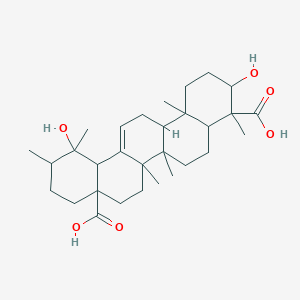
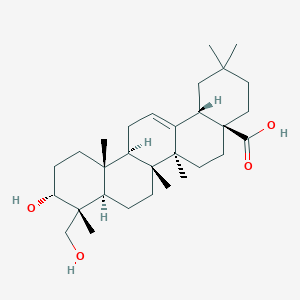
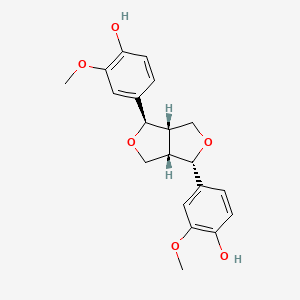


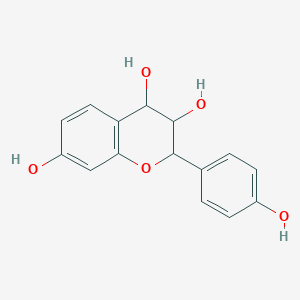
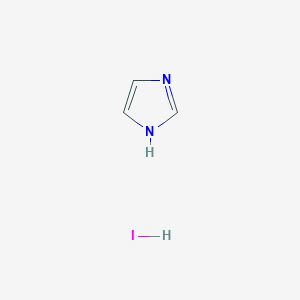
![1-Azabicyclo[2.2.2]octane-2-carboxylic acid hydrochloride](/img/structure/B1631607.png)
